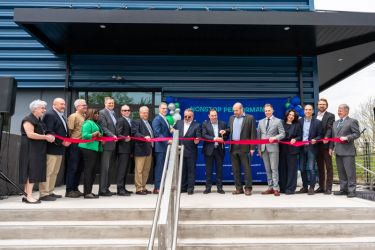
 The NEPA region is primed for growth in the healthcare industry. Regional consolidation of smaller hospitals into nationally recognized healthcare systems, coupled with a demographic need for more primary and specialty care, gives the region the opportunity to expand its clinical offerings. Strong university partners in medical education, allied health professional training, research programs, and healthcare administration programs give the region a natural advantage as this sector continues to grow. Recruitment of talent is virtually unlimited due to our proximity to more than 20 academic medical institutions in Boston, New York, Philadelphia, and Baltimore.
The NEPA region is primed for growth in the healthcare industry. Regional consolidation of smaller hospitals into nationally recognized healthcare systems, coupled with a demographic need for more primary and specialty care, gives the region the opportunity to expand its clinical offerings. Strong university partners in medical education, allied health professional training, research programs, and healthcare administration programs give the region a natural advantage as this sector continues to grow. Recruitment of talent is virtually unlimited due to our proximity to more than 20 academic medical institutions in Boston, New York, Philadelphia, and Baltimore.
NEPA REGIONAL STRENGTHS
- National Health Systems Have Made Large Investments: There is a significant amount of growth and change in the healthcare sector throughout the 8-county region. Over $200 million is being invested in the next five years to upgrade and expand healthcare facilities in NEPA.
- More than $1 Billion in Healthcare Revenue Available to Capture: With more than $1 billion annually in patient care revenue flowing outside of the NEPA region, there is significant revenue to be made through expanded specialty healthcare services. The regional market is poised for transformation in its specialty healthcare sector.
- Strong Healthcare Sector Growth is Projected: Healthcare is a strong growth area for NEPA. The industry segment represents $4.1 billion in economic output and supports more than 32,000 jobs. The demand for employees with training in the medical professions (Bachelor’s degree or higher) in NEPA is projected to increase by 14.3% over the next five years. With a strong college & university sector in place to fill the growing demand for medical professionals, NEPA is primed to transform and grow its healthcare sector.
- Growing Pool of Primary Care Physicians: The Health Resources and Services Administration (HRSA) recently awarded a $4 million grant to the Wright Center for Graduate Medical Education in NEPA to fund a new graduate education model that aims to help address America’s shortage of primary care physicians.
- New Medical School Grows Out of Historic Collaboration: The nationally recognized partnership of healthcare, higher education, civic, and economic development organizations who developed The Commonwealth Medical College remain in place and ready to grow patient care programs and services. NEPA knows how to collaborate for our collective success. Over 50 organizations are currently partnering with NEPA RBI to realize the potential of the biosciences in the region.
- Geriatric Care Opportunities in NEPA and Beyond: The region has an aging population requiring increased medical care; thereby increasing the need for more healthcare professionals – both clinical and administrative. NEPA has one of the highest populations over 65 years of age (17.9% of residents are over the age of 65, compared to 15.4% in PA and 12.9% nationally). As the U.S. population continues to age, the NEPA region is able to demonstrate to the nation how to care for an older population, improve healthcare outcomes, and provide cutting-edge clinical care close to home.
INVESTMENT OPPORTUNITIES
- Specialty Medical Care and Destination Medicine
- More than $1 billion in healthcare spending leaves the NEPA region annually.
- Specialty medical providers can easily capture patients who would rather receive specialty care close to home.
- Capitalizing on more than $1 billion in patient care revenue provides a ready-made market for sub-specialist physicians and programs to join existing and new healthcare organizations.
- Access to interstates 78, 80, 81, 84, 476, and 380 allow patients to access cutting-edge hospitals and medical facilities in NEPA more conveniently and at significantly lower cost than hospitals in metropolitan areas.
- Rehabilitation companies with geriatrics are a demonstrated center of excellence. These companies can position themselves in NEPA as a provider of lower cost, high-quality, and long-term rehabilitation care as they work in partnership with established providers such as Allied Services Rehabilitation Hospital.
ASSISTANCE ON WORKFORCE AND TRAINING
Geisinger-Community Medical Center offers on-going career training programs for professionals under the Organizational Development Department. G-CMC also provides additional training in the following programs: The Pediatric Advanced Life Support Provider Renewal Program, The Advanced Cardiac Life Support Provider Program, Trauma Nurse Course and Interpreting Cardiac Rhythms Program.
The Pediatric Advanced Life Support Provider Renewal Program, The Advanced Cardiac Life Support Provider Program and Trauma Nurse Course are available to employees as well as to the public at a fee. Also, the hospital has Health Care Provider CPR classes and Health Care Provider Renewal CPR classes that are open to all healthcare providers in the community.
UNIVERSITY AND COLLEGE SUPPORT FOR DIRECT PATIENT CARE
There is a strong university and college presence coupled with technical training programs that are focused on educating and training the future workforce to meet the demands of the growing healthcare sector in the region. The 8-county region has sophisticated biosciences and health sciences programs that are very responsive to local company needs.
Programs include:
- Critical technology programs, including: biomedical equipment technology programs and programs in radiology.
- There are a number of strong Allied Health Programs; cardiac, surgical, diagnostic, and vascular.
- The 8-county region has strong programs in Applied Health Sciences, with degrees in Registered Nurse, Physician’s Assistant, Medical Assistant, Respiratory Technician, and Surgical Technician.

